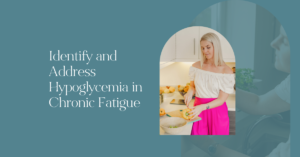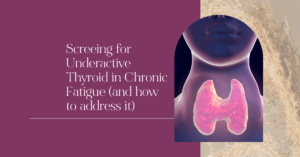Building Your Nutrition Foundations For Fatigue Recovery
When we consider eating for energy we want to distinguish between eating for an instant energy boost versus eating for sustainable energy and health long term.
If you are someone who is experiencing a chronic illness – such as Chronic Fatigue Syndrome (CFS/ME), PoTS, Fibromyalgia or an Autoimmune Condition – then you definitely want to focus on the latter and avoid the former.
If you begin to google different diets to support your health, it’s easy to get overwhelmed pretty quickly with all the options.
Do you need to be low carb or low fat? Gluten Free? Dairy Free? Paleo, Keto, Carnivore or Autoimmune Paleo. What does eating more more energy actually mean?
The truth is, it depends.
Each of us, even if we have the same diagnosis, is a different human. Therefore, the needs and metabolism of one person may differ for another.
When you are already sick and tired, it can be overwhelming to try and work it all out on your own. Therefore, the intention of this blog is to give you a simple and structured starting point so that you can make dietary changes one at a time.
You can gradually refine your diet over a period of weeks or months based on the feedback your body gives you and being the detective of your own metabolism.
Don’t rush your body to make changes that feel overwhelming – your nervous system won’t thank you for it – instead my initial guidance is:
1. Be slow, keep it simple and be methodical.
2. Focus on what you are adding in, more so than what you are removing i.e. crowding out the less helpful foods versus removing too much and being left depleted.
3. If the people you live with can make similar changes or at the very least, support you with what you need to do, even if it isn’t ideal for them, you are much more likely to succeed.
Start With Food Quality
If you want to eat for more energy, the quality of your food is the first thing you’ll want to address. This means increasing whole, single ingredient foods like:
Proteins:
Meat, Eggs, Fish, Beans & Legumes, Nuts and Seeds, High Quality Dairy
Fats:
Olive oil, avocado, nuts and seeds, fats in oily fish, eggs and fatty meats, cold pressed seed oils, butter, cream, ghee, cheese, coconut milk, yoghurt, oil or butter, dark chocolate, nut butters
Carbohydrates:
Vegetables, Fruits, Wholegrains, Beans and Legumes
And decreasing foods like:
- Crisps
- Biscuits
- Chocolates
- Cakes
- Pasta
- White Rice
- White Bread
- Refined Sugar
- Alcohol
- Fizzy drinks
- Sugary Cordials
You’ll want to the bulk of your diet to come from wholefoods but that transition doesn’t have to happen overnight, keep moving forward in the direction of more wholefoods in your diet.
Meal Stability
Stable energy requires meal stability. If you want more energy, you’ll want more stability.
People who experience fatigue, whether that is Chronic Fatigue Syndrome or another Chronic Illness, need routine. It helps to give them a sense of stability that is important for recovery.
Therefore, as you work on crowding out your diet with wholefoods, you can begin to stabilise your meals.
The goals you may be aiming for are as follows:
- Aim to eat 3 main meals per day
- Each meal should keep you going until the next meal but if it doesn’t you can always have a small snack – aim to get the bulk of calories from your main meals so you aren’t overly reliant on snacks.
- Each meal should be centred around protein, then add a fat and fibre source (like a vegetable or fruit).
- Carbohydrates should be eaten according to blood sugar tolerance – which is another phase of refinement that comes later. For now, if you feel you need a carbohydrate, aim to half a serving that is the size of ½ -1 cupped handful.
Nuance:
Of course there is always nuance for individual needs when it comes to eating for more energy. Here are some examples:
- Hypoglycemia; for someone who experiences hypoglycemia which is episodes of low blood sugar, eating more frequently in the short term may be beneficial. These meals should still be balanced with good amounts of proteins, fats and fibre. You may be prone to hypoglycemia if:
- You feel more energised after eating
- You lose mental function or experience dizziness and this is relieved by eating
- You get hangry and cannot skip a meal
- Hyperglycemia or Hyperinsulinemia; for someone who is prone to high blood glucose and high insulin levels we may want to reduce meal frequency and introduce fasting. This is a more advanced practice. You may be prone to hyperglycemia / hyperinsulinemia if:
- Your energy drops after eating
- You wake feeling unrefreshed
- You have an HB1AC >36
Protein Goal
By this point in time, unless you have nuanced requirements you are ideally eating 3 meals a day from wholefoods that have a protein, fat and fibre source.
When it comes to eating for more energy, the next step of refinement is making sure you eat enough protein. The majority of my clients do not eat enough protein so this is a step that you don’t want to skip.
What is enough protein?
Ideally you want to eat between 0.75g to 1.0g of protein per pound of ideal body weight. That means, that if your ideal body weight was 140 pounds, you would want to eat between 105g protein and 140g of protein per day.
This does not mean that if you eat 140g lean chicken breast, then you’ve nailed it. 100g of uncooked chicken contains 20g of protein. To hit your protein goal you would need to eat approximately 500g to 700g of uncooked chicken.
Obviously you don’t only have to eat chicken – and please cook it if you do eat it! – you will get the bulk of your protein from:
- Different cuts of meats – the leaner, the higher the protein content
- Fish and Seafood
- Whole eggs or egg whites (6g of protein per egg)
- Nuts and seeds
- Beans and lentils
- Yoghurts and Cheese
- Small amounts in vegetables
- Protein powders – which you can use in smoothies, baking or even to thicken soups and stews
You can use an app like My Fitness Pal to keep a food diary for a couple of weeks and see how you are doing. This is a step I take with almost all my clients at some point on their journey.
Adequate protein supports healthy blood sugar, it increases satiety and it helps with muscle mass which is important for healthy ageing.
Nuance: If someone has compromised digestion I may recommend a lower protein intake in the short term while we support digestion. Once digestive health is restored we can increase protein intake incrementally to the levels described here.
Carbohydrate Tolerance
By now the bulk of your diet is wholefoods, you are having balanced meals each day and hitting your protein goal. What next?
The next step is to establish your carbohydrate tolerance. To do this you will need a blood glucose monitor like this one.
You’ll want to eat your regular diet and monitor your blood glucose. Blood glucose should fluctuate in a narrow range, between 4 mmol/L and 6.1mmol/L. You’ll want to use your glucose monitor to see if you fall inside or outside this range.
How you do this is by:
- Measure your glucose before a meal to get a baseline
- Measure your glucose at 45min to 1 hour post-meal to capture what would normally be your glucose peak (this should be below 6.1 mmol/L)
- Measure your glucose at 2 hours post-meal where ideally it should have returned close-ish to baseline or at the very least below 5.5 mmol/L
What to do with this data?
If your blood glucose is well enough within the healthy range and you will good after meals (i.e. no energy changes) then you can keep doing what you are doing.
If your glucose is too high 45 minutes to 1 hour after meals or remaining too high (>5.5mmol/L) at the two hour mark, then something has to change.
This might mean changing the types or quantities of carbohydrate in your meals until you can optimise your response.
Health permitting you may need to increase your activity levels or take a short walk after meals.
There can be other causes of poor glucose control such as nutrient deficiencies, gut imbalances or high stress. Sometimes it can take a while to find the optimal balance and solve other issues which might be contributing to imbalances.
It is here we can employ a little bit of time restricted feeding and or reduce meal frequency to give blood sugar a healthy hand. This might look like:
- Eating all meals in a 8-12 hour window
- Limiting meals to 3 per day or two meals and a small snack
Be slow, be patient, be methodical.
Calorie Check
I don’t often find myself needing to do calorie checks with my clients but sometimes it can be helpful.
If someone is under-eating this can cause hypoglycemia which can impact energy levels, stress levels, sleep, sex and thyroid hormones and contribute to nutrient deficiencies.
If someone is over-eating this can lead to blood sugar imbalances, increased histamine, inflammation and metabolic dysfunction.
It can be interesting at the very least to check calories using an app like My Fitness Pal just for a week or two so that you can rule this out as a problem. Individual calorie needs may vary depending on things such as age, size, muscle mass and activity levels of the individual. Roughly speaking I like to see clients eating around 1600-2200 calories per day depending on these variables.
Specialised Diets
By now you should have some solid foundations in place and it might be prudent to look at specialised diets depending on your case history.
This might be:
- Gluten Free; beneficial for those with digestive issues
- Diary Free; beneficial for those with digestive issues especially sinus issues and skin issues like eczema
- Paleo; beneficial for those avoiding grains and dairy
- Autoimmune Paleo; beneficial for autoimmune conditions
- Low Mycotoxin; beneficial for those exposed to mycotoxins
- Low Histamine; beneficial for those with histamine intolerance or MCAS
- Keto; beneficial for those who struggle with blood sugar control
- Low FODMAP Diet; beneficial for gut digestive issues
- Low Sulphur Diet; beneficial for digestive issues
- Fasting; beneficial for those who struggle with blood sugar control
- Carnivore; beneficial for those who struggle with blood sugar control or digestive issues
- And more…
There are many reasons why more specialised diets could be helpful for someone with Chronic Fatigue Syndrome or a Chronic Illness but there is no one size fits all approach.
I make decisions around dietary interventions based on clients symptoms, health history, test results and feedback to interventions.
For example, if someone tested positive for Tissue Transglutaminase, an indicator for celiac disease, I would ask them to eat a gluten free diet, irrespective of whether they had worked through all the steps in this blog.
Ultimately I want my clients to have a diet that they enjoy and for that diet to be as diverse as possible. I don’t want them to have to go to restaurants and be scrutinising the menu and checking everything with the Chef or feeling stressed about meals with friends or travelling abroad.
However, sometimes we may need some restriction in the short term with the goal to expand in the long term.
In my own journey I had to follow a strict ketogenic diet for blood sugar control. It was the only thing that allowed my blood sugar to stabilise as described in this blog. Additionally, due to digestive issues, I had to follow a low sulphur diet – which is actually quite hard to do in conjunction with keto.
Eating out was not fun because it always felt like there was nothing I could eat or I was cobbling together things on the menu to make something work. I had to be very clear with friends and family what I could and couldn’t eat and although they did their best, they never quite “got it” and I was often eating things I shouldn’t just to fill myself up.
It wasn’t fun for anyone.
But…now I am in a place where I can eat all the sulphur foods I used to avoid AND I am gradually expanding my carbohydrate tolerance to include things like sweet potato, quinoa and berries. If I want a treat like a brownie or a cake I typically choose a gluten free option (as my blood sugar tends to respond better to these than wheat based flours) and I’ll plan a walk or something before or after to help my muscles mop up the extra sugar.
We’re all different and we all need to find a way that works for us and most importantly, helps us feel better.
Need More Help?
If you’ve come this far and you still feel a little overwhelmed with how you can be supporting your energy with the power of food then I am here for you. You can find out more about working together here.










